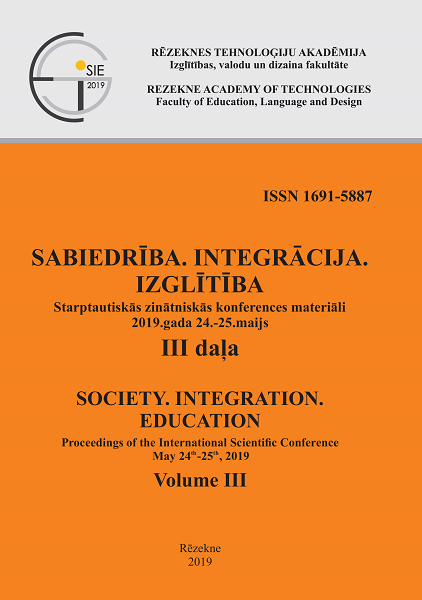A COOPERATION BETWEEN VOCAL TEACHER AND SPEECH AND LANGUAGE THERAPIST IN THE TREATMENT OF MULTIFACTORIAL VOICE DISORDERS
DOI:
https://doi.org/10.17770/sie2019vol3.3793Keywords:
dysphonia, cooperation, postural alignment, breathing, vocal exercisesAbstract
The aetiology of voice disorders is multifactorial. Neglecting of vocal hygiene and medical factors are common causes of voice disorders. The critical elements of the holistic approach to voice therapy are postural alignment, breathing and support, phonation and the speaking voice.
The aim of the study is to make an analysis of the efficiency of the interdisciplinary treatment approach in a client with multifactorial voice disorders.
Methods. This is a case study. The 57 years old female with moderate functional dysphonia received intervention by the vocal teacher and speech-language therapist. The following voice assessment methods were used in the study: a gathering of anamnesis, voice acoustic analysis, voice self-assessment. The vocal teacher used the following treatment methods: postural alignment exercises, Anna Sims’s breathing exercises, vocal and articulation exercises. Stemple’s Vocal function exercises, resonance therapy and biofeedback, were used by the speech-language therapist.
Results. The harmonisation of posture, breathing, vocal folds vibration was achieved during the therapy. The objective measurements demonstrate improvement in Dysphonia Severity Index as well as the Voice Handicap Index. The client demonstrated satisfaction with the improvement of voice function.
Conclusion. The cooperation of vocal teacher and speech-language therapist diversifies therapeutic approaches which allow finding unique, client-oriented intervention and achieving positive output.
Downloads
References
Aronson, A.E., & Bless D.M. (2009). Clinical Voice Disorders. 4th ed. New York, Stuttgart: Thieme.
Awan, S. N. (2006). The aging female voice: acoustic and respiratory data. Clinical Linguistics & Phonetics, 20(2), 171-180.
Bērziņa, I. (2017). Dziedāšana un elpošanas vingrinājumi dusmu mazināšanai bronhiālās astmas pacientiem mūzikas terapijā, 122-137. Mūzikas terapija I, zinātnisko rakstu krājums. Liepāja: LiePa
Carroll, L.M. (2006). The Role of the voice specialist in the nonmedical management of bening voice disorders. In Rubin, Sataloff, Korovin (Eds.), Diagnosis and treatment of voice disorders.
Chapman, Janice. L. (2006). Dziedāšana un dziedāšanas apmācība, holastiska pieeja klasiskai balsij, 2. izlaidums. Tulkojis Toms Ostrovsikis. Neiespiests darbs, glabājas Jāzepa Vītola Latvijas Mūzikas akadēmijas grāmatu nodaļā, 268
Chen, S.H., Chiang, S.C., Chung, Y.M., Hsiao, L.C., Hsiao, T.Y. (2010). Risk factors and effects of voice problems for teachers. Journal of Voice, 24(2), 183-192.
Eglīte, M. (2000). Darba Medicīna. Rīga: Latvijas Arodslimību ārstu asociācija, 704
Mattiske, J.A., Oates, J.M.. Greenwood, K.M. (1998). Vocal problems among teachers: a review of prevalence, causes, prevention and treatment. Journal of Voice, 12(4), 489-499.
Ozoliņa-Nucho, A.; Vidnere, M. (1998). Stresa menedžments: pārvarēšana un profilakse. Rīga: Izdevniecība AGB, 176
Ozoliņa-Nucho, A.; Vidnere, M. (2004). Stress, tā pārvarēšana un profilakse, psiholoģija jūtu kultūrai. Rīga: Apgāds Biznesa Partneri, 256
Preciado-López, J., Pérez-Fernández, C., Calzada-Uriondo, M., Preciado-Ruiz, P. (2008). Epidemiological study of voice disorders among teaching professionals of La Rioja, Spain. Journal of Voice, 22(4), 489-508.
Sala, E., Hellgren, UM, Ketola, R., Laine, A., Olkinuora, P., Rantala, L., Sihvo, M. (2009). Balss ergonomikas novērtējums darba vietā. Helsinki: Tyoterveyslaitos.
Sataloff, R. T. (2006). Vocal Health and Pedagogy. San Diego, California: Plural Publishing, Inc.
Sims, A (2014, Novembris) Vokālās meistarklases Akademia Muzyczna im. Karola Lipińskiego we Wrocławiu. Vroclava
Sliwinska-Kowalska, M., Niebudek-Bogusz, E., Fiszer, M. (2006). The prevalence and risk factors for occupational voice disorders in teachers. Folia Phoniatrica et Logopaedica, 58, 85-101.
Svence, G. (1999). Attīstības psiholoģija, mācību līdzeklis. Rīga: Zvaigzne ABC, 159
Trinīte, B. (2007). Balss un tās traucējumi. Liepāja: Liepa, 79
Киножурнал Советский Спорт 1986 № 10, часть к/п №1 [videoieraksts]. [skatīts 19.01.2019.]. Pieejams arī: https://www.net-film.ru/film-14499
Лавров, Н.Н., Бубличенко М.М. (2005), Дыхание по Стрельниковой. Росток-на-Дону: Феникс, 128


